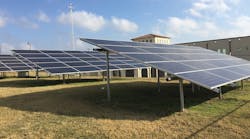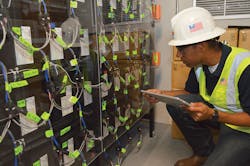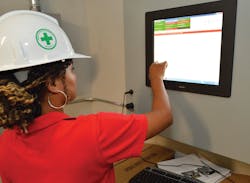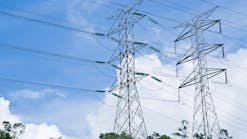As the electric power industry pushes the boundaries of what is achievable with technology, utility customers are demanding increased reliability, resiliency and greater access to renewable energy sources. It is no longer satisfactory to rely on the legacy way of doing things. As a result, innovation and testing has become a core business function. Utilities now feel the need to investigate how to offer more product choice to their customers. This extends to renewable energy sources. In addition, increased demands from customers have resulted in a need to further strengthen the provision of service. Evidence of this can be seen across the world, particularly in Europe and the U.S.
CPS Energy — the largest municipally owned energy utility in the U.S., providing both natural gas and electric services — is meeting this challenge by participating in a project of the U.S. Department of Energy’s National Renewable Energy Laboratory (NREL). Powered by OMNETRIC Group and Siemens, Project INTEGRATE is aimed at resolving the current constraints utilities face when integrating distributed assets, including renewable energy sources, into the grid.
This work accounts for just one of many projects CPS Energy is participating in to ensure better, stronger and more sustainable service for its customers. The promising results prove true renewable integration without disruption is entirely possible and, if all goes well, will be a reality in the not-too-distant future.
The Interoperability Challenge
A lack of common systems and standards used by today’s utilities has traditionally led to difficulties in the communication and interoperation of renewables within the complex multivendor operating systems. Compounding this problem is the multifaceted and variable nature of renewable energy resources themselves, all of which require integration.
Typically, it is exceptionally challenging to bridge the gap between existing legacy systems and new developments, and to enable devices on the grid to be interoperable. As a result, the process for renewable integration historically has been done at a slow pace, which is far from ideal.
Project INTEGRATE
This was the context for Project INTEGRATE, one of the largest innovation projects in which CPS Energy has ever participated. Working with OMNETRIC Group, CPS Energy installed a microgrid solution at the Joint Base San Antonio’s Fort Sam Houston military post — a post consisting of a 20-kW solar photovoltaic array, a 48-kWh battery, a weather station provided by the University of Texas at San Antonio for solar forecasting, and a Siemens microgrid management system (MGMS).
The demonstration was designed to test control of the microgrid under live conditions, particularly with respect to renewable integration. The aim was to help advance the integration of renewables and the development of microgrid systems on a larger scale, in line with the demands of customers, both now and in the future. As part of the solution, OMNETRIC Group, which specializes in bridging the gap between operations and information technology systems, verified and implemented a new interoperability reference architecture called the Open Field Message Bus (OpenFMB) framework. This solution was integrated with a Siemens MGMS.
The framework will enable utilities to overcome the lack of standardization and interoperability between the vast arrays of equipment in operation so they can better manage load behavior on the grid. In turn, this enables the distributed applications on the microgrid test site to optimize renewable energy resources and battery storage locally. It also provides the customer with a cleaner, greener and more reliable service.
Promising Results
The ongoing Project INTEGRATE has already delivered exciting results. The augmented operational systems, enhanced integration, better grid-edge interoperability and distributed intelligence will help to deliver an advanced and environmentally focused future on behalf of CPS Energy customers.
The utility has been able to illustrate the capability of controlling the microgrid with precision. Specifically, there is the ability to disconnect a customer from the grid in a live environment with no impact to service. This will revolutionize the technology change process, and it will mean customers with a critical need for service consistency, such as hospitals and military bases, will be afforded greater confidence and, ultimately, reduced change disruption.
In turn, this continuity of service increases the possibility for a greater number of renewable energy sources to be used independently of the grid. This will improve resiliency of the grid and provide a response to the ever-increasing demand for greener energy sources. CPS Energy is still using Project INTEGRATE as a key test site and plans to expand the use cases to improve the service portfolio further.
The utility is extremely interested in the potential of interoperability and advancing capability in this space. There are plans to develop this work further with OMNETRIC Group and other partners, including the University of Texas at San Antonio. Another priority for CPS Energy is data analytics, which is now seen as a core competency. It allows operations to be enhanced and offers a better understanding of customers’ issues. This will enable the utility to provide the best products and services possible.
A large amount of data is being collected at the Project INTEGRATE site. The process of managing this data and interpreting the intelligence it offers is ongoing. It is recognized that for analytics to be valuable, the data used to generate information needs to come from operations technologies such as this, as well as the information technology systems that manage related business processes.
A Greener Future
The success of this project has motivated CPS Energy to apply lessons learned to other projects, particularly when it comes to integrating renewable resources. There is an interest in plug-and-play technologies and making different systems and technologies work together seamlessly. The ambition is to learn from the use of the new communications architecture to solve other interoperability challenges utilities generally face.
Ultimately, this will lead to offering customers a greater choice of products in the future and an even greater reassurance of service reliability. In doing this, it is of paramount importance to develop an intelligent infrastructure that is sustainable in nature, allowing for continual evolution and integration without the need for a full-scale change.
CPS Energy is eager to use technology to modernize the electric grid to benefit both the customer and the utility. The seamless integration of distribution assets is another step toward having the ability to offer the next generation of reliability, resiliency and product choice. All eyes are looking forward to the developments this will bring to the market. The commitment to the advancement of renewable integration in the grid is very real, and the work on this deployment, in conjunction with both OMNETRIC Group and Siemens, has only furthered its potential. ♦
James Boston is the manager of market intelligence for CPS Energy. In his current role, he has managed the implementation of CPS Energy’s first microgrid testbed and is overseeing CPS Energy’s large-scale BESS installation. Boston holds a BSEE degree from the University of Texas at San Antonio and is a licensed professional engineer in the state of Texas.
Sidebar: Grid-Edge Control Hierarchy
Traditionally, electric utilities have employed centralized control systems to keep the electric grid operating optimally, focusing mainly on balancing load with generation and, to the extent possible, controlling power flows on the transmission grid. For the most part, distribution feeders have been controlled passively through the use of protection devices, such as capacitor banks, that help the feeder ride through electrical disturbances or breakers that would trip the feeder offline.
However, as a growing number of distributed energy resources, such as solar photovoltaic (PV) systems, are being interconnected to feeders, utilities are looking to gain greater control of their distribution systems. The reason, in part, is the need for greater voltage control, as excess PV capacity on a feeder can drive up voltages on a sunny day, potentially causing the power to reverse and flow back toward the substation.
As a result, utilities are looking for a means of “grid-edge” control, that is, actively controlling what is happening on the distribution system. A system that provides automated or coordinated control of all of a utility’s distribution lines could yield significant benefits in terms of allowing the greater use of renewable energy, providing demand-side management and increasing feeder reliability. That’s why NREL worked with OMNETRIC Group, which is a joint venture between Siemens and Accenture, under the laboratory’s Integrated Network Testbed for Energy Grid Research and Technology Experimentation (INTEGRATE) project.
Open Field Message Bus
OMNETRIC Group, in collaboration with Siemens, has developed a distributed control hierarchy that is based on an open field message bus (OpenFMB) framework to allow control decisions to be made at the edge of the grid. This in turn enables more timely responses to changing conditions. This open-source-based, interoperable platform allows distributed energy assets to communicate in real time with intelligent grid devices in the field. As part of the INTEGRATE project, OpenFMB was demonstrated to support large-scale complex operations, which allow for the integration and wider penetration of renewable energy resources.
This approach was first developed and validated in NREL’s Energy System Integration Facility (ESIF) with a combination of hardware and software simulations representing real-world utility-scale operations. The ESIF validations included testing data exchanges with the representative renewable energy devices available at NREL, while the ESIF grid simulator was used to test balancing renewables with other resources.




